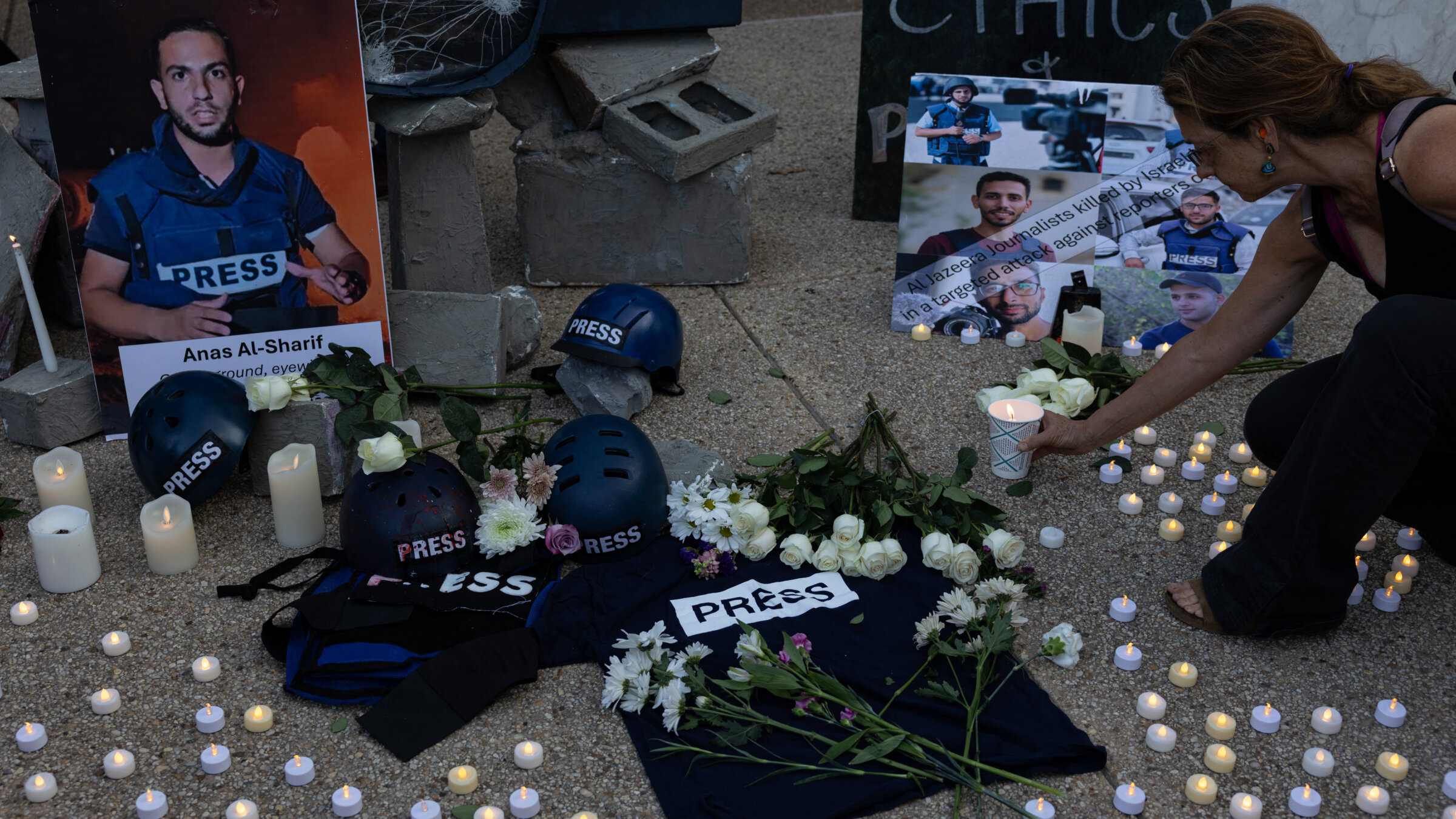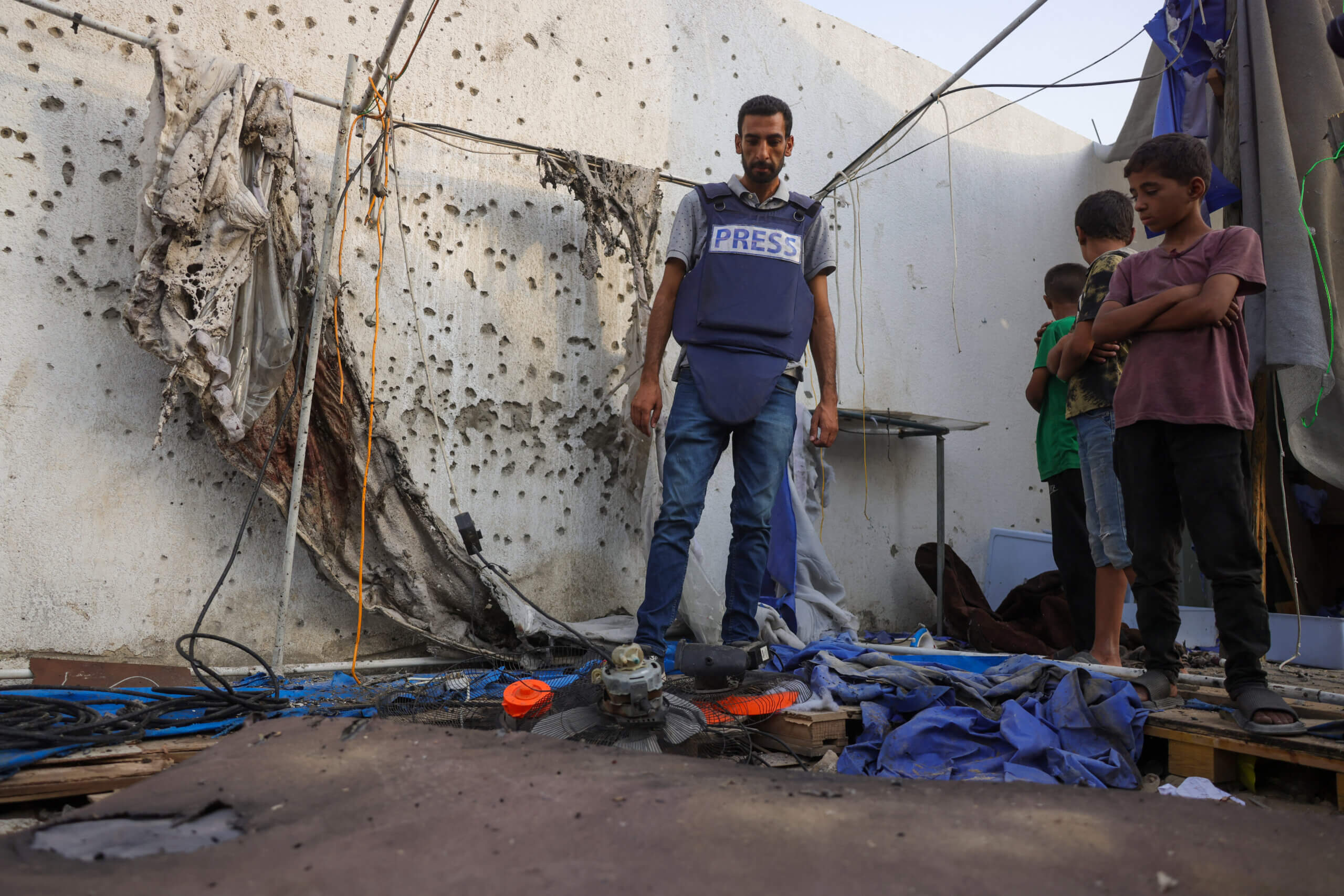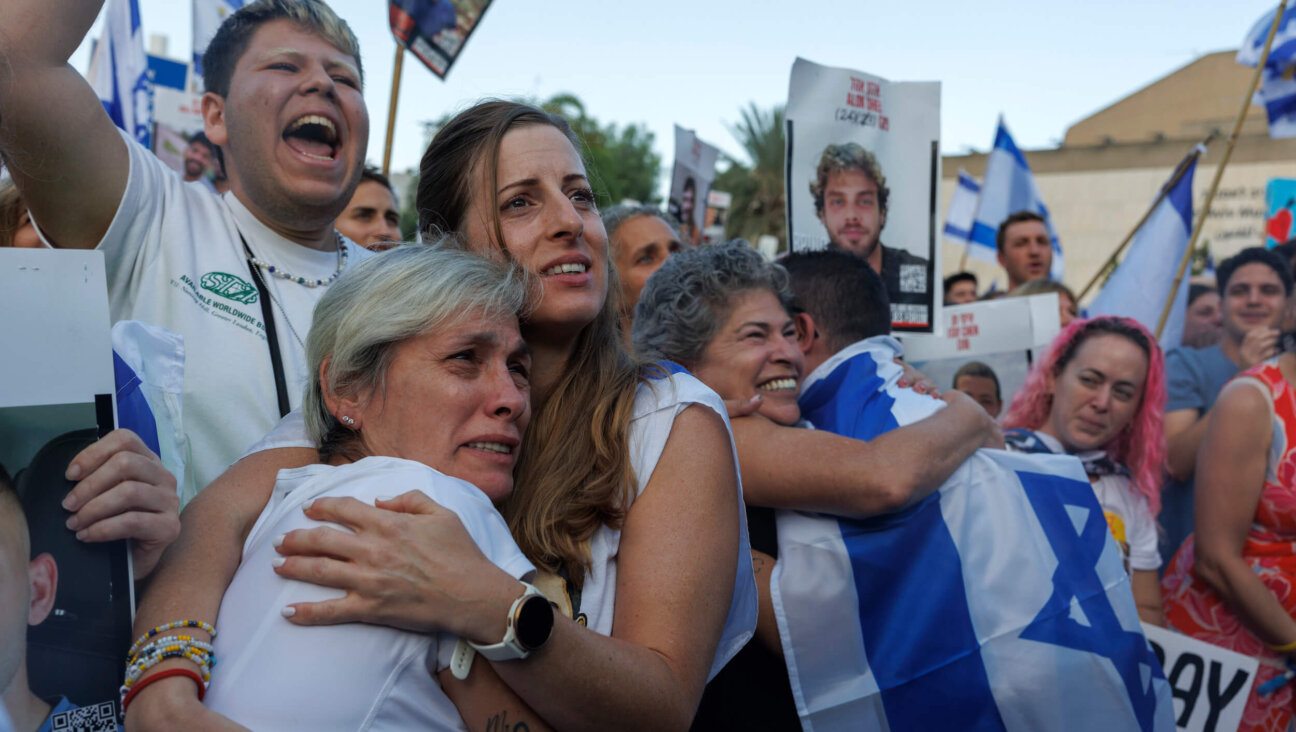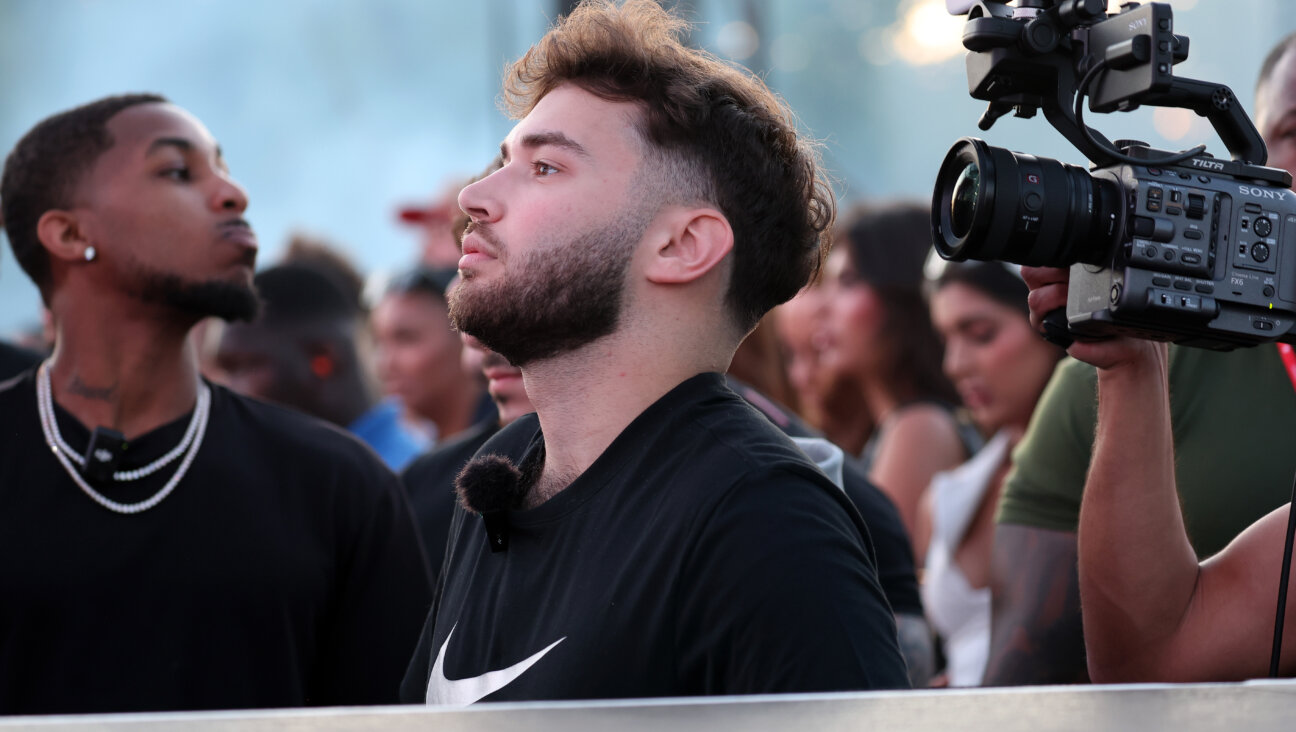The world is outraged by a reporter’s death in Gaza. It’s part of a much bigger problem.
The IDF killed Anas al-Sharif, a prominent Al Jazeera journalist, in a targeted strike

A vigil for Palestinian journalist Anas al-Sharif outside the Fox News and NBC News headquarters in Washington, D.C., on Aug. 11. Photo by Mehmet Eser/Middle East Images/AFP via Getty Images
“I really don’t know what to believe,” an acquaintance messaged me earlier this week, about the death of Anas al-Sharif, a prominent Al Jazeera journalist in Gaza who was killed by the Israeli military last Saturday along with three of his colleagues. Al-Sharif’s death provoked international condemnation, and his poetic final message on his X account — which he wrote was only to be released in the event of his death — had gone viral.
The Committee to Protect Journalists reports that more than 180 journalists have been killed in Gaza since the war began, 26 of whom, including al-Sharif, it describes as being “murdered” in targeted killings. Yet the Israel Defense Forces said they had targeted al-Sharif because he was commanding “a Hamas terror cell.”
Pro-Israel accounts excoriated the global outrage, claiming al-Sharif was a terrorist who was legitimately targeted. (The IDF said that in October 2024, they discovered documents in Gaza that proved al-Sharif had received a salary from Hamas and was a former member of a military wing.) Al Jazeera has vociferously denied these allegations, and claims the documents were fabricated. “If there is no free press in Gaza, if Hamas controls it all, how are we to believe he’s innocent?” my acquaintance asked. “I really struggle with all of this.”
That question — how can any of us know what information about events in Gaza is real? — is one shared by many. Since Oct. 7, 2023, Israel has barred foreign journalists from entering Gaza, unless they are embedded with an Israeli military escort who decides where they will go and what they will see. On such visits, journalists are not permitted to speak to Palestinians.
Which means the sole source of reporting from within Gaza is the Palestinian journalists who live there, whose credibility Israel and its supporters often call into question. That dynamic means that media outlets striving to deliver a complex, multifaceted story to readers have found themselves, instead, trapped in an inflammatory war of narratives.
Orly Halpern, a freelance journalist for Time magazine who has covered Israel, the West Bank and Gaza for nearly 30 years, sees three major problems impeding coverage of Israel’s war in Gaza — starting with the IDF preventing foreign press from accessing the strip.
That policy is new, Halpern said in an interview. In previous conflicts with Hamas, Israel has occasionally blocked foreign press access to Gaza, but never for so long.
Halpern herself last entered Gaza two weeks before the Israeli soldier Gilad Shalit was captured by Gaza-based militants in 2006. After Shalit’s kidnapping, Israel barred Israeli citizens from entering the strip as journalists, but foreign press were still permitted to enter freely. Until 2023, foreign journalists would stay in hotels in Gaza to cover the conflict when wars periodically broke out.
After al-Sharif’s death, Netanyahu said he has directed the military to allow more foreign journalists into Gaza. In Halpern’s view, that’s misleading.
“These statements are suggesting he’s in favor, but he’s talking about embeds,” she said — the scenario in which a journalist is accompanied by an Israeli military escort and, generally, only allowed to speak to Israeli soldiers. “The army controls what they see, and there are no ways to examine it. That’s not journalism,” she said.
At the same time, the Israeli military and press regularly discredits Palestinian journalists in Gaza as Hamas sympathizers or even Hamas militants — the second major issue Halpern believes journalists are facing.
That happened with al-Sharif. Less than two weeks before he was killed, Irene Khan, the United Nations Special Rapporteur on freedom of expression, made a statement denouncing “the serious threats and accusations” made by the IDF against al-Sharif.
“Fears for al-Sharif’s safety are well-founded as there is growing evidence that journalists in Gaza have been targeted and killed by the Israeli army on the basis of unsubstantiated claims that they were Hamas terrorists,” she said.
The IDF made similar claims earlier in the war, including in the high-profile case of Hamza al-Dahdouh, a journalist for Al Jazeera who was killed in a targeted strike on Jan. 7, 2024, as he returned from a reporting trip with other journalists. The IDF claimed afterward that documents had been found in Gaza proving that al-Dahdouh had been a member of Palestinian Islamic Jihad.
Without independent substantiation, it is hard to take these kinds of claims from the Israeli military at face value.
Earlier this week, reporting emerged that Israel’s army intelligence had created a special unit called “the Legitimization Cell,” whose sole task is to find information linking Palestinian journalists to Hamas. The head IDF spokesperson, Rear Adm. Daniel Hagari, has publicly said that “every journalist that dies is unfortunate.” But, in many cases, the IDF has alleged that either those journalists, or someone they were in close proximity to at the time of their deaths, were terrorists.
This is a particularly thorny issue for readers, many of whom may understandably feel that if someone has at any point been a member of a terrorist organization, they may not qualify for the same protections to which press in wartime are generally entitled.
Halpern frames the issue differently. Even if al-Sharif was at one point affiliated with Hamas — the documents the IDF found, which have not been independently verified, allege he was a member of the military wing in 2013, and received a salary from Hamas as late as 2019 — he was murdered while serving as a civilian journalist. According to the logic that would justify his death under these circumstances, Halpern said, practically all Israelis would be considered legitimate targets in war, since most have served in the IDF.

There are legitimate concerns about the degree to which journalism is tainted by Hamas’ influence in Gaza. Journalists like Matti Friedman have argued that there is no free press in Gaza, and that Hamas controls what information local journalists are able to share. During his time at the Associated Press Jerusalem bureau, Friedman claims, his editors removed details from at least one story due to Hamas pressure on its Gaza staff.
But even if Hamas does pressure local journalists to avoid criticizing it during wartime, Halpern argued, it’s practically impossible for the organization to control the narrative around the starvation and colossal suffering Palestinians are experiencing — because of the scale of the devastation. “If you use your eyes, you can see what is happening,” she said.
If foreign press aren’t allowed in, and Palestinians are not trusted to report their own story, then the media is left, Halpern said, with only one source: the IDF, which is “providing us with their version of events to take at face value.” As any journalist can verify, to base a story on a single source — especially a story about a situation as complex and chaotic as war — does not make for healthy, or balanced, journalism. (To report this piece, I examined sources including The Free Press, the BBC, The Hill, The Guardian, The Jerusalem Post, The Washington Post, the Committee for the Protection of Journalists, the Foreign Press Association, Al Jazeera and The Times of Israel.)
Most egregious, in Halpern’s view, is what she views as an excessive dependence on IDF background briefings that are given by IDF spokespeople but required to be attributed to “senior military sources.” The IDF is not an impartial source of information, and an overreliance on their official interpretation of events threatens to narrow our understanding of the full, complex, picture, she said.
“We are essentially deceiving the readers,” Halpern says. “It is unethical. A spokesman with an agenda is far less reliable.”
On Dec. 19, 2023, the Foreign Press Association — a nonprofit that represents journalists at international outlets who report on Israel, the West Bank and Gaza — filed a petition to Israel’s Supreme Court to gain “immediate access to the Gaza Strip for international media.” Their request was initially rejected; the FPA appealed; and for nearly two years, their hearing has been repeatedly delayed by the court.
It is currently scheduled to convene on the issue in October, but Halpern, a board member at FPA, expects more delays.
If the court “agrees with the military lawyers and keeps us out, it would lose its standing as a place in high moral regard,” she said.
But for the meantime, Halpern has a suggestion for how journalists should adjust. Earlier this week after al-Sharif’s death, she posted an idea on LinkedIn that went semi-viral. “It’s time,” she wrote, “for media bosses to consider to suspend the use of IDF statements on Gaza until journalists are granted access.”

















